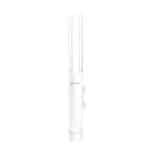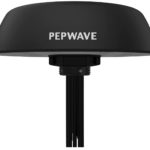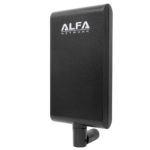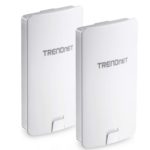Best WiFi Antenna in 2022
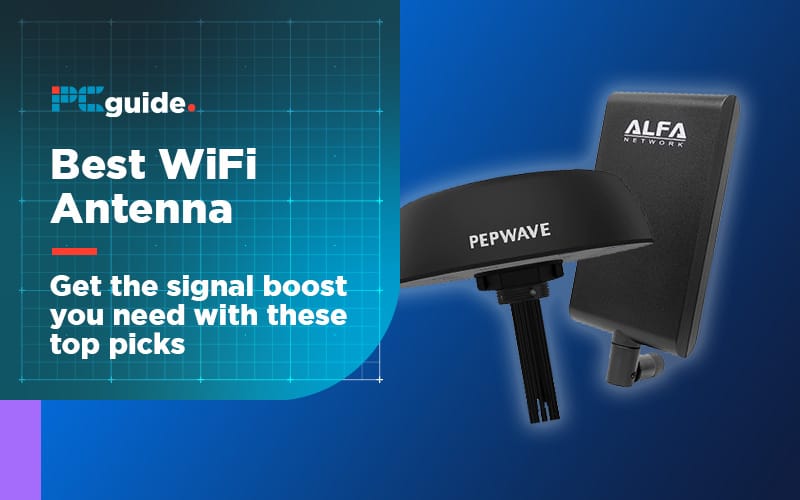
Whilst it’s widely assumed that WiFi signals are produced in waves, this isn’t always the case. There are two types of Wi-Fi antenna, omnidirectional and directional. The former produces a wider yet weaker signal, whilst the latter produces a strong signal which is projected directly to devices. See, you’re learning already!
For example, the best WiFi antenna for shops and offices are dome ceiling WiFi antennas. These antennas produce a wide signal for devices in a large room to pick up. These would fall into the omnidirectional category. Yagi antennas are a great example of directional antennas. Shaped like an arrow, they must be pointed at the target device as they only have around a 45° radius.
Products at a Glance
What’s The Best Wi-Fi Antenna For Me?

Usually, this decision weighs heavily on distance and what you need to get out of your network. A gamer with sole access to the households WiFi would probably benefit from a directional antenna upgrade over a bridging system for example (more on that later). The best WiFi antenna for multiple users would likely be an omnidirectional one. Whilst it doesn’t provide a connection on-par with a directional antenna, the best WiFi antenna in this scenario would be one that multiple users can connect to simultaneously.
We’ve chosen the best Wi-Fi antennas, two omnidirectional and directional, one high-end and one budget, to help you make an informed decision whilst being inclusive of all needs. We’ve also included where to buy to take the weight off finding a bargain.
Best WiFi Antenna in 2022
- Can be used indoors and outdoors
- Sleek design unlike other outdoor antennas
- Not every device can use beamforming
Marketed as the best WiFi antenna access point solution for outdoor business use, AC1200 also looks the part as an indoor home office setup. It features a dual antenna sleek design so as to not make a user’s home look like a flight path (Although you can check out our flight simulator 2020 content if that’s your bag).
It’s weatherproof which gives users the flexibility of indoor or outdoor use, which comes in handy as it rocks a 200m WiFi range and 2.4GHz and 300m at 5GHz. TP-Link has included the latest mesh WiFi support, which means (providing your main router is compatible and supports mesh) that AC1200 acts as its own network, rather than forcing all internet traffic directly via the router.
Working alongside mesh support is beamforming, this is another handy feature that directs WiFi signal directly to a beamforming compatible device. Beamforming is supported as standard on 802.11ac (WiFi 5) but not every device is required to come with it. If this is a feature you’re looking to use, check that your current network and devices support it.
- Supports 5G and GPS
- Multiple fitting options
- Only needed to cover large areas/vehicles
Puma 421 is the best WiFi antenna that includes 5G. It’s a 7-in-1 antenna with 4×4 MIMO cellular, 2×2 WiFi antennas, and GPS. It supports the latest 5G bands including band 71 and is a beastly piece of equipment for anyone looking to provide an all-in-one solution to their home network in remote locations or on-the-go scenarios.
In fact, Puma 421 is built primarily for 5G as well as WiFi. The 4×4 MIMO (Multiple-input and multiple-output: It’s one of the key technologies that allows 4G LTE and 5G to deliver high speeds) antennas are held up by a 600-6000MHz frequency range, which makes for a very reliable connection radius.
When it comes to WiFi, the 2X2 MIMO Dual Band (2.4GHz and 5GHz) high gain omnidirectional antennas won’t let you down. Its dome design is windproof, weatherproof, and even salt waterproof, so those lucky readers who live near the coast will have zero issues mounting this in outdoor areas. Puma 421 also looks great mounted onto ceilings, but just remember cables will need to be fitted into your local Giga switch or router. There is an option to wall mount it for easier installation.
- Simple installation
- Great signal boosting features for price-point
- High gain (10DBi)
- Can only be attached via RP-SMA connector
APA-M25 is a great budget entry device for directional WiFi signals. Ideal for small networks with single devices, its high gain (10dBi) panel antenna will ensure users are getting the best WiFi antenna signals from their routers at this price point.
Boosting the range of factory default router ranges by up to four times, this adaptor fits all VOIP and PCI cards with an RP-SMA connector. Long story short, unscrew the stock antennas on that Wi-Fi adaptor and pop this bad boy on for maximum range. Users have seen a signal boost increase of over 30% in some cases.
As with other directional best WiFi antennas, users will need to line the Alfa APA-M25 up to their access point with some degree of precision. The vertical beam-with is 16°, with horizontal coming in at 66°. A quick Google search will point you in the direction of third-party testing software alongside browser-based testing to find the best position. Usually, a speed test will show how well a connection is working, the higher the upload and download speed the better the connection.
- Provides secondary router support in out-of-range areas
- Fast data transfer
- PoE adaptors included if needed
- Alignment needs to be pretty accurate
TRENDnet’s pre-configured access points are a brilliant solution for buildings running on one modem router. AC867 panels bridge to each other which saves on additional accounts with your internet service provider, covering up to 60m (two-thirds of a football pitch).
Setting up access points can seem daunting, but it’s actually quite simple. Let’s say the router is in the house, but its signal doesn’t reach the garage where the office/games room is. You’ll need to plug in one access point into your main router (if it’s not a PoE compatible one, simply plug in the included adapter) and have it pointing at the garage.
Next, you’ll need another access point on the garage facing the master access point attached to the main router. Plug this into a secondary router via ethernet cable in the garage and connect your devices to the secondary router.
You’ll be able to enjoy data rates of up to 867Mbps (most ISP routers knock out around 400Mbps) thanks to the 802.11a/n/ac 5Ghz complaint WiFi signal, which is miles better than trying to use plug-in WiFi extenders any day of the week.
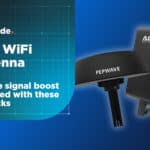
Best WiFi Antenna in 2022
What Does Wireless Banding Type Mean?
802.11 is the radio frequency transmitted at, the term dual band represents the 2.5Ghz and 5Ghz frequency bands 802.11 is capable of. The G and AC at the end represents the linkrate (internet speed). For example, 802.11ac is capable of over 6000mb/s.
What Does MU-MIMO do?
MU-MIMO stands for multi-user, multiple input, multiple output. It’s for multiple users trying to connect to one router at the same time. To take advantage of this, a user’s router must also have this feature.
What’s The Difference Between 2.5Ghz and 5Ghz?
2.5Ghz provides a wider/longer WiFi range with slower speeds, whilst 5Ghz provides faster speeds with a shorter range. Most modern devices and internet provider routers support both, so there’s nothing to worry about here
What does 802.11 a/n/ac mean?
To cut a long story short, 802.11ac is a supercharged version of 802.11n. 802.11ac is dozens of times faster, and delivers speeds ranging from 433 Mbps (megabits per second) up to several gigabits per second. This is also known as WiFi 5.
What is an RP-SMA connector?
Forgoing the technical name, it’s the female counterpart to the coaxial RF connectors developed in the 1960s. They’re the same connections and cables that screw into the back of your satellite/cable TV services.
What’s Omada SDN?
TP-Link Omada SDN separates network management data from user data, with no user traffic passing through the cloud, ensuring better protection for user’s privacy. Long story short, it processes network-related internet uses in the cloud.
What’s PoE?
Power over Ethernet (PoE) is a means of carrying electrical power through data cables. With PoE-enabled devices, electrical current passes through the ethernet cable along with the data normally carried by an ethernet cable.
What’s WDS?
WDN stands for ‘wireless distribution system’. It enables the wireless interconnection of access points in a network. For example, a wireless network can be expanded using multiple access points without a requirement for wires to link them
What’s Bridging?
This is when two directional access points are aligned to transfer a connection from one point to the other. This usually involves one panel being plugged into the main router with the receiving panel jacked into a secondary router in another building.
Our Verdict
WiFi Antennas are very subjective. For users who just want a powerful WiFi connection to their desktop from a router in the next room, a big budget omnidirectional antenna isn’t going to be appropriate. However, that same antenna would solve some major WiFi range issues in a large house with multiple devices connecting to WiFi. We’ve tried to pick the best product to match budget and need, so ultimately there are multiple best solutions here.
For ease of use though, we’d have to say TP-Link Omada AC1200 wins out for the best all-round features at an affordable price-point. It can be used inside and outside whilst providing enough range to cover most uses for home and office environments.


